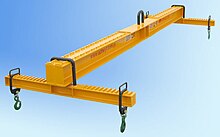Lifting beam

The lifting beam (also known as traverse, spreader beam) is a steel beam that is attached to the hook of the crane in order to spread the slings from one end of an elongated load (like a wall panel) to another. The bottom of the beam has multiple connection points for hanging of the load.[1]

The lifting beams are used in multiple cases:[2]
- lifting an asymmetrical load. Without a beam, it might be hard to strap the load so that its center of gravity is exactly below the hook;
- handling a long load with a single-hook crane. Sufficient spread between the slings prevents the load from slipping out;
- increase the headroom: slings cannot be stretched close to horizontal direction, so attaching them directly to the hook requires minimum distance from the hook to the load. When the lifting beam is used, the slings can be shorter, providing more vertical clearance during lifting;
- if the attachments of the load are on its vertical sides, the slings have to go over the edges of the load and can damage these edges. A lifting beam allows attaching slings to the side lugs without touching the edges;
- the top of the beam can have two attachment points at the ends thus allowing two cranes to share the load.
See also[edit]
References[edit]
- ^ Gorse, Johnston & Pritchard 2012, p. 250, lifting beam.
- ^ Kulweic 1991, pp. 525–527, Lifting Beams.
Sources[edit]
- Gorse, C.; Johnston, D.; Pritchard, M. (2012). A Dictionary of Construction, Surveying, and Civil Engineering. Oxford Paperback Reference. OUP Oxford. ISBN 978-0-19-953446-3. Retrieved 2024-05-05.
- Kulweic, R.A. (1991). "Lifting beam". Materials Handling Handbook. A Wiley-Interscience publication. Wiley. pp. 525–526. ISBN 978-0-471-09782-2. Retrieved 2024-05-05.
- Zhu, Changbiao; Miao, Wenfeng; Xu, Kun; Mei, Xiao; Li, Changbin (2024). "Lifting Attachments of Cranes". Handbook of Port Machinery. Singapore: Springer. pp. 745–844. doi:10.1007/978-981-99-4848-2_8. ISBN 978-981-99-4848-2. Retrieved 2024-05-05.
